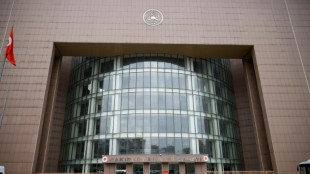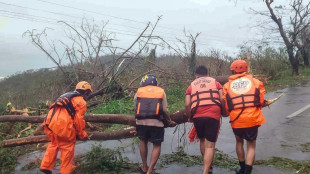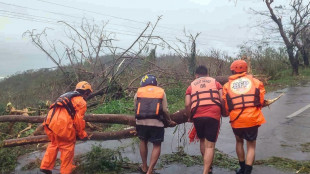
-
 Kane hoping to extend England career beyond 2026 World Cup
Kane hoping to extend England career beyond 2026 World Cup
-
Gazans rebuild homes from rubble in preparation for winter

-
 'Vague' net zero rules threaten climate targets, scientists warn
'Vague' net zero rules threaten climate targets, scientists warn
-
Stocks, dollar hesitant as traders eye US rate outlook, Nvidia

-
 G20 wrestles with wars, climate in run-up to Trump
G20 wrestles with wars, climate in run-up to Trump
-
'Agriculture is dying': French farmers protest EU-Mercosur deal

-
 Beyonce to headline halftime during NFL Christmas game
Beyonce to headline halftime during NFL Christmas game
-
Rescuers struggle to reach dozens missing after north Gaza strike

-
 Russia vetoes Sudan ceasefire resolution at UN
Russia vetoes Sudan ceasefire resolution at UN
-
G20 host Brazil launches alliance to end 'scourge' of hunger

-
 Stocks, dollar hesitant as traders scale back US rate cut bets
Stocks, dollar hesitant as traders scale back US rate cut bets
-
Trump confirms plan to use military for mass deportation

-
 Schools closed in Beirut after deadly Israeli air raid
Schools closed in Beirut after deadly Israeli air raid
-
Anger, pain in Turkey as 'newborn deaths gang' trial opens

-
 Kremlin says Biden 'fuelling' war as Russian strikes rock Odesa
Kremlin says Biden 'fuelling' war as Russian strikes rock Odesa
-
UN climate chief at deadlocked COP29: 'Cut the theatrics'

-
 G20 leaders gather to discuss wars, climate, Trump comeback
G20 leaders gather to discuss wars, climate, Trump comeback
-
Stocks, dollar mixed as traders scale back US rate cut bets

-
 Stoinis lets rip as Australia crush Pakistan for T20 series whitewash
Stoinis lets rip as Australia crush Pakistan for T20 series whitewash
-
Bentancur banned for seven games over alleged racial slur

-
 Kremlin says Biden 'fuelling' tensions with Kyiv missile decision
Kremlin says Biden 'fuelling' tensions with Kyiv missile decision
-
COP host Azerbaijan jailed activists over 'critical opinions': rights body

-
 Composer of Piaf's 'Non, je ne regrette rien' dies aged 95
Composer of Piaf's 'Non, je ne regrette rien' dies aged 95
-
South African trio nominated for World Rugby player of year

-
 'Not here for retiring': Nadal insists focus on Davis Cup
'Not here for retiring': Nadal insists focus on Davis Cup
-
Tractor-driving French farmers protest EU-Mercosur deal

-
 Floods hit northern Philippines after typhoon forces dam release
Floods hit northern Philippines after typhoon forces dam release
-
Pakistan skittled for 117 in final T20 against Australia

-
 Schools closed in Beirut after deadly Israeli strike
Schools closed in Beirut after deadly Israeli strike
-
Chris Wood hits hat-trick in NZ World Cup qualifying rout

-
 Markets mixed after Wall St losses as traders weigh US rates outlook
Markets mixed after Wall St losses as traders weigh US rates outlook
-
US, Philippines sign deal on sharing military information

-
 Bangladeshi ex-ministers face 'massacre' charges in court
Bangladeshi ex-ministers face 'massacre' charges in court
-
Law and disorder as Thai police station comes under monkey attack

-
 Disgraced Singapore oil tycoon sentenced to nearly 18 years for fraud
Disgraced Singapore oil tycoon sentenced to nearly 18 years for fraud
-
Philippines cleans up as typhoon death toll rises

-
 Quincy Jones awarded posthumous Oscar
Quincy Jones awarded posthumous Oscar
-
'Critically endangered' African penguins just want peace and food

-
 Long delayed Ukrainian survival video game sequel set for release amid war
Long delayed Ukrainian survival video game sequel set for release amid war
-
Star Australian broadcaster charged with sex offences

-
 Philippines cleans up after sixth major storm in weeks
Philippines cleans up after sixth major storm in weeks
-
Woman-owned cafe in Indonesia's Sharia stronghold shakes stigma

-
 Indigenous Australian lawmaker who heckled King Charles censured
Indigenous Australian lawmaker who heckled King Charles censured
-
End of an era as Nadal aims for winning Davis Cup farewell

-
 Trump taps big tech critic Carr to lead US communications agency
Trump taps big tech critic Carr to lead US communications agency
-
Mitchell-less Cavs rip Hornets as perfect NBA start hits 15-0

-
 Markets swing after Wall St losses as traders weigh US rates outlook
Markets swing after Wall St losses as traders weigh US rates outlook
-
India's capital shuts schools because of smog

-
 Rio under high security for G20 summit
Rio under high security for G20 summit
-
G20 leaders to grapple with climate, taxes, Trump comeback


The secret agents of the Michelin Guide
They are paid to eat in the best restaurants in the world -- but the price is having to lie even to their friends about the job.
Hidden amongst hundreds of guests descending on the 16th century Chateau de Chambord in the Loire Valley for a luxurious dinner ahead of the Michelin Guide's annual ceremony on Monday was the group's covert inspectors.
One guest at the weekend event told AFP he worked in the automobile industry -- plausible given Michelin's main business of selling tyres.
But his knowledge of France's best restaurants was suspiciously encyclopedic.
Whether or not he was a Michelin inspector would remain a mystery, since they are sworn to secrecy.
Each year, the guide receives 8,000 spontaneous applications to become an inspector, its boss Gwendal Poullennec told AFP.
The key criteria are "professionalism" and "openness" -- to travel, different cultures and new experiences, he added.
Michelin does not say how many it employs -- part of the strict secrecy it maintains to ensure they are never recognised by a restaurant and given preferential treatment.
The guide does reveal that its inspectors currently include 25 different nationalities, and men and women of all ages, operating across the 45 destinations covered by Michelin.
- Undercover -
It is a full-time job, and all are drawn from the world of fine dining and hospitality: applicants must have at least 10 years of experience as chefs, sommeliers or hoteliers, according to the guide's website.
A new inspector is paired with a more experienced colleague for a training period of up to two years -- or around 800 meals -- to learn the Michelin method, the organisation told AFP.
The inspector then lives undercover. Only their inner circle of family are allowed to know -- and they have an interest in keeping quiet since they often tag along to meals to avert suspicion.
The most common cover story that inspectors give their friends and wider family is that they are "consulting" with restaurants on their business strategies -- a good excuse to travel and indulge.
They give false names and even change their phone numbers when making reservations -- vital since many restaurants now have applications to scan their bookings for journalists and potential inspectors.
The reviews require an excellent memory. The inspector must recall the tiniest details of the food, service and ambiance -- right down to the appearance of the toilets -- without taking notes, though phone pictures are now common.
They must also research the wider context -- the restaurant's suppliers, how it fits into the local community and its finances.
The final report sticks to five criteria: the quality of the ingredients, the culinary technique, the harmony of the flavours, the emotion which the chef is seeking to convey through their menu, and the restaurant's consistency over time. The latter requires multiple visits.
The awarding of a star -- with three stars as the absolute pinnacle -- must be a unanimous choice when inspectors meet to discuss their reviews.
If there is disagreement, further visits are organised until a consensus is reached.
T.Sanchez--AT




